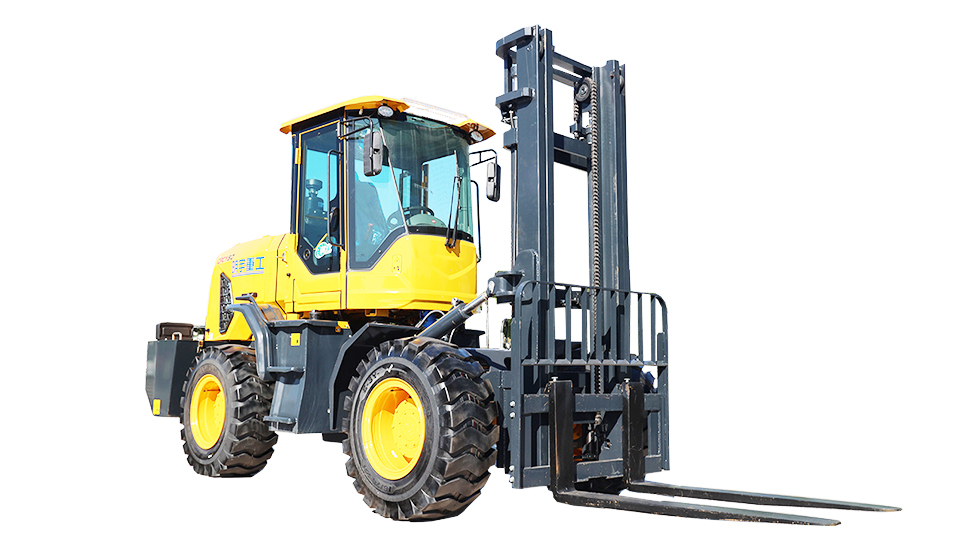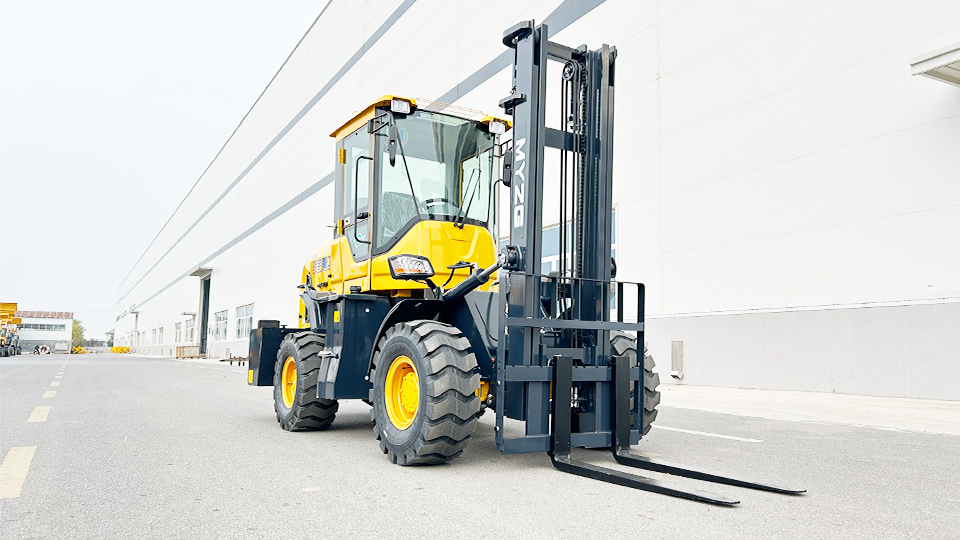
Abstract:
Off-road forklifts operate in challenging environments, from muddy construction sites and uneven lumber yards to gravel pits and agricultural fields. The performance, safety, and operational efficiency of these machines are profoundly dependent on the proper selection of tires. This article delves into the critical factors influencing tire choice for off-road forklifts, examining the various tire types, their construction, tread patterns, and rubber compounds. It provides a comprehensive guide for fleet managers and operators to make informed decisions that minimize downtime, enhance productivity, and ensure operator safety in demanding outdoor conditions.
1. Introduction
The modern off-road forklift is a workhorse, designed to navigate terrains that would incapacitate standard warehouse equipment. From the chaotic, debris-strewn landscape of a construction site to the soft, uneven ground of a farm, these machines are indispensable for material handling where paved surfaces are non-existent or unreliable. However, the inherent challenges of these environments – sharp objects, variable ground conditions, extreme temperatures, and heavy, often unstable loads – place immense stress on one of the most critical components of any forklift: its tires.
The seemingly straightforward choice of "a good, tough tire" is, in reality, a complex engineering decision. The wrong tire choice can lead to frequent punctures, excessive wear, reduced traction, compromised stability, increased fuel consumption, operator fatigue due to excessive vibration, and ultimately, costly downtime and potential safety hazards. Conversely, selecting the optimal tire for a specific off-road application can significantly enhance a forklift’s performance, extend its operational life, improve fuel efficiency, and ensure a safer, more comfortable experience for the operator. This article aims to demystify the selection process by providing a detailed technical overview of the various tire types available for off-road forklifts, their construction methodologies, the impact of tread patterns and rubber compounds, and a comprehensive set of factors to consider when making this crucial investment. Understanding these technical nuances is paramount for any fleet manager or operator seeking to maximize the utility and longevity of their off-road material handling equipment.

2. Understanding Off-Road Forklift Tire Types
The foundation of effective off-road forklift performance lies in choosing the correct tire type. While indoor forklifts typically utilize cushion or polyurethane tires designed for smooth, hard surfaces, off-road applications demand significantly more robust and resilient solutions. The primary categories for off-road use are pneumatic, solid pneumatic, and foam-filled tires, each with distinct characteristics, advantages, and disadvantages.
2.1 Pneumatic Tires (Air-Filled)
Pneumatic tires for forklifts are analogous to those found on cars or trucks, relying on compressed air for inflation. They feature an inner tube or are tubeless, providing a vital layer of cushioning between the forklift and the ground.
2.1.1 Construction and Characteristics: Pneumatic tires are constructed with multiple layers of rubber and fabric plies (e.g., nylon or polyester cords), often reinforced with steel belts in radial designs, all designed to contain air pressure. Their construction allows for deflection upon impact, absorbing shocks and distributing weight across a larger footprint. The "ply rating" or "load index" indicates the tire's strength and maximum load-carrying capacity, with higher ratings signifying greater durability and load support. Maintaining precise air pressure is critical for optimal performance, as underinflation can lead to excessive heat buildup and premature wear, while overinflation can reduce the contact patch and increase susceptibility to cuts.
2.1.2 Advantages: The primary benefit of pneumatic tires is their superior shock absorption. The air cushion provides a much smoother ride for the operator, significantly reducing whole-body vibration (WBV) and operator fatigue over long shifts on uneven terrain. This cushioning also protects the forklift's components (e.g., axles, transmission) from excessive jarring, potentially extending the machine's lifespan. Furthermore, their flexible sidewalls allow them to conform to uneven surfaces, offering excellent traction and grip in conditions like loose gravel, dirt, and moderately muddy environments. Their versatility makes them suitable for a wide range of outdoor applications.
2.1.3 Disadvantages: The most significant drawback of pneumatic tires is their vulnerability to punctures. Nails, rebar, sharp rocks, and other debris commonly found on construction sites or in scrap yards can easily cause flats, leading to costly downtime for repairs or replacement. They also require regular maintenance, including frequent air pressure checks, which can be overlooked in busy operations. In severe puncture scenarios or if not properly maintained, blowouts can occur, posing safety risks. They tend to have a shorter lifespan than solid alternatives in abrasive environments due to wear and puncture susceptibility.
2.1.4 Applications: Pneumatic tires are ideal for rough terrain forklifts operating in construction sites, lumber yards, agricultural fields, large outdoor storage facilities, and any environment where operator comfort and superior traction on varying, unpaved surfaces are prioritized. They perform well where debris is present but not overwhelmingly sharp or numerous enough to cause constant punctures.
2.2 Solid Pneumatic Tires (Resilient Solid Tires)
Solid pneumatic tires, also known as resilient solid tires, are a hybrid solution that visually resembles air-filled pneumatic tires but are constructed entirely from solid rubber. They are designed to fit onto standard pneumatic rims.
2.2.1 Construction and Characteristics: These tires are made of multiple layers of highly durable solid rubber compounds, often with a layered construction (e.g., 2-layer for intermittent use, 3-layer for continuous heavy use) bonded to an internal steel ring for secure mounting. Their solid composition means they do not contain air. This construction provides a robust, heavy-duty alternative to air-filled tires, offering exceptional resistance to damage.
2.2.2 Advantages: The paramount advantage of solid pneumatic tires is their absolute immunity to punctures. This translates to zero downtime from flats, a critical factor in environments abundant with sharp debris. Their solid structure also provides enhanced stability for heavy loads, as there is no air to compress or shift. They require minimal maintenance compared to air-filled tires, as there's no air pressure to monitor. This combination leads to a longer operational lifespan in high-risk environments and a lower total cost of ownership over time by eliminating puncture-related expenses.
2.2.3 Disadvantages: The trade-off for puncture resistance is a significantly rougher ride. Without an air cushion, solid pneumatic tires transmit more shock and vibration to the forklift and its operator, leading to increased operator fatigue and potential long-term wear on the machine's components. They are also heavier than pneumatic tires, which can slightly increase fuel consumption and put more strain on the forklift's driveline. Heat buildup can be a concern in continuous, high-speed applications, as the solid rubber can retain heat, potentially accelerating wear. Their initial cost is often higher than standard pneumatic tires.
2.2.4 Applications: Solid pneumatic tires are the preferred choice for forklifts operating in extremely hazardous, debris-laden environments such as scrap metal yards, recycling centers, demolition sites, and heavy industrial settings where sharp objects are an ever-present threat. They are also well-suited for mixed indoor/outdoor applications where machines frequently transition between paved and unpaved surfaces with a high risk of punctures.

2.3 Foam-Filled Tires (Flat-Proofing)
Foam-filled tires represent an innovative solution that bridges the gap between air-filled pneumatics and solid tires. This process involves pumping a liquid polyurethane compound into a standard pneumatic tire, replacing all the air. The polyurethane then cures into a solid, resilient elastomer.
2.3.1 Construction and Characteristics: The core concept is to take a pneumatic tire, with its designed tread pattern and sidewall flexibility, and permanently flat-proof it. The polyurethane fill creates a dense, synthetic rubber core within the tire. This process results in a tire that is effectively puncture-proof while still offering some of the deflection properties of an air-filled tire, albeit with a firmer feel. The durometer (hardness) and pressure of the fill can be customized to some extent to tailor performance to specific applications.
2.3.2 Advantages: The most compelling advantage is complete flat-proofing without the inherent hardness of a traditional solid tire. This eliminates costly downtime due to punctures while retaining better traction and handling characteristics than a purely solid tire on uneven ground. Foam-filled tires maintain consistent tire pressure and deflection, offering predictable performance. The added weight of the foam fill can also contribute to enhanced stability for the forklift, particularly beneficial when handling heavy or high loads on uneven terrain. They are often seen as a superior compromise, combining the flat-proofing of solids with some of the ride quality and traction of pneumatics.
2.3.3 Disadvantages: Foam-filling is a permanent modification; the tires cannot be reverted to air-filled. They are significantly heavier than standard pneumatic tires, which can impact fuel efficiency and add stress to the forklift's drive components and wheel bearings due to the reduced "rebound effect" compared to air. While offering a smoother ride than solid tires, they are still harsher than air-filled pneumatics, leading to increased operator vibration and potential for wear on forklift components over time. The initial cost is higher than both standard pneumatic and often solid pneumatic tires, reflecting the cost of the specialized filling process. Heat buildup can also be an issue in high-speed, continuous operations, similar to solid tires.
2.3.4 Applications: Foam-filled tires are exceptionally well-suited for high-risk puncture environments such as construction sites, municipal waste facilities, recycling operations, and mining or quarry environments where the benefits of pneumatic-like traction are desired, but puncture risk is unacceptable. They are a popular choice for rough terrain telehandlers and forklifts that demand continuous operation in severe conditions.
2.4 Other Less Common/Contextual Types (Brief Mention)
While not typically used for demanding off-road tasks, it's worth briefly distinguishing other forklift tire types:
2.4.1 Cushion Tires: These are made of solid rubber and pressed onto a steel band. They are designed for smooth, indoor surfaces like warehouses, offering good traction and a tight turning radius. They are entirely unsuitable for off-road use due to their lack of cushioning, low ground clearance, and susceptibility to damage from uneven terrain.
2.4.2 Polyurethane Tires: Lightweight and resistant to splitting, tearing, and chemicals, polyurethane tires are primarily used for specific indoor applications, often where lighter loads are moved at slower speeds (e.g., cold storage, food processing). Like cushion tires, they offer no off-road capability.
Name: selena
Mobile:+86-13176910558
Tel:+86-0535-2090977
Whatsapp:8613181602336
Email:vip@mingyuforklift.com
Add:Xiaqiu Town, Laizhou, Yantai City, Shandong Province, China